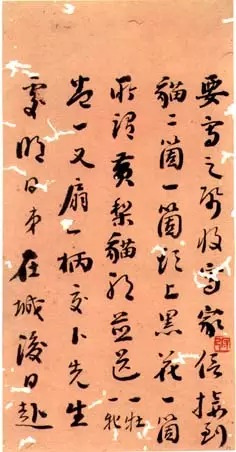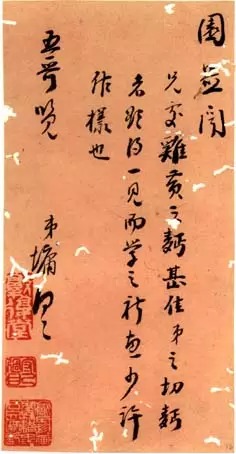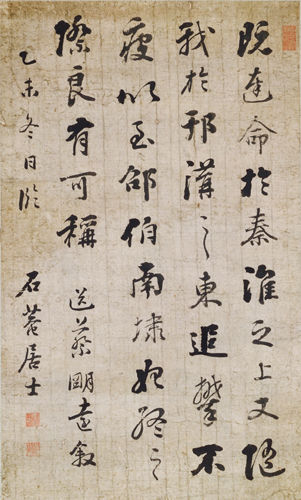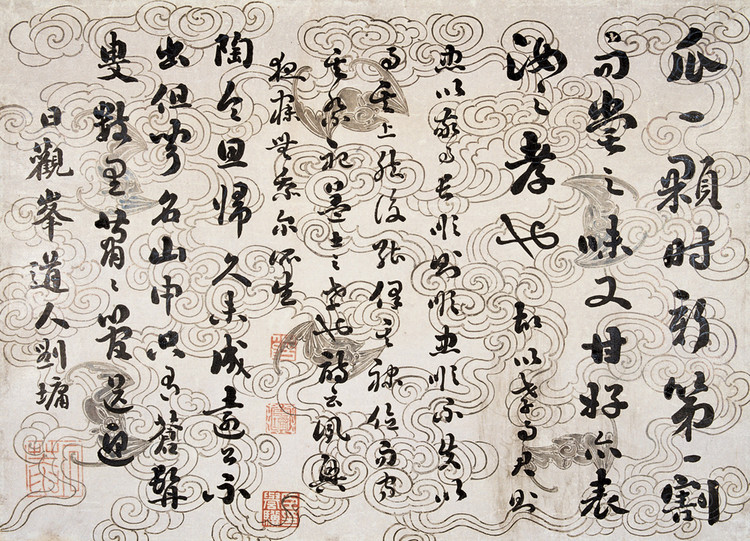The official career and humanistic calligraphy of Liu Yong, the "prime minister with thick ink"
Liu Yong was a calligrapher, painter, and statesman in the Qing Dynasty (1719-1804). His courtesy name was Chongru and his alias was Shi'an. He also had the aliases of Qingyuan, Xiangyan, Dongwu, Mu'an, Minghua, and Riguanfeng Taoren. He was also known as Pangge in Zhucheng County. A native of Zhuang (now Gaomi City, Shandong Province), he was the son of Liu Tongxun, a bachelor.
Liu Yong was awarded Jinshi at the age of 32 in the 16th year of Qianlong's reign in the Qing Dynasty (1751). He was originally the number one scholar in the imperial examination. However, at the insistence of his father Liu Tongxun, Qianlong changed Liu Yong's rank to the first in the second class, and he was awarded the title of editor in the 17th year of Qianlong's reign. build. In the 20th year of Qianlong's reign, when Liu Tongxun was the governor of Shaanxi and Gansu, he agreed with General Yongchang to handle the matter improperly due to the investigation of the military garrison in Barkol Hami. Liu Yong was also implicated and dismissed from his post, and was handed over to the Ministry of Punishment for prosecution. In October, Qianlong ordered his release. Re-taught editor. After that, he served as the chief examiner of the Guangxi Provincial Examination and the admiral of Anhui's academic affairs. In the 31st year of Qianlong's reign, Liu Yong was found guilty of neglecting his duties in the Yangqu County magistrate's case of successfully embezzling treasury items when he was the prefect of Taiyuan. Walking around the book repair office. Later, he served as the prefect of Jiangning Prefecture in Jiangsu Province and the inspector of Shaanxi Province. In the thirty-eighth year of Qianlong's reign, Liu Yong and Ding's father were worried, and in the forty-one year of Qianlong's reign, he went to Beijing. Qianlong recalled that Liu Tongxun had "long proclaimed his power, and his knowledge of military equipment could be used", so he awarded Liu Yong a cabinet bachelor's degree. He worked in the South Study Room, served as the vice president of Siku Quanshu Library, and took over the compilation of "Illustrated Records of the Western Regions" and "Japanese Records". Books such as "Xiajiu Wen Kao". After that, he successively served as governor of Zhili, minister of the Ministry of official affairs, and chief master of the study room. In the second year of Jiaqing (1797), he was awarded the bachelor's degree of Tirenge. Liu Yong died in December of the ninth year of Jiaqing. Emperor Jiaqing was grateful for Liu Tongxun's outstanding contribution, so he gave Liu Yong a favor as a gift to the crown prince, and enshrined him in the Xianliang Temple, giving him the posthumous title "Wenqing".
Liu YongHe has been honest and devoted to public service throughout his life, always considering the interests of the people, and is deeply loved by the people. He has never embezzled a penny of money or a utensil from the country. When building dams and bridges, he led the people and staff to work hard on the front line. The clothes are shabby and they eat coarse grains. His favorite food is pancake rolls with green onions. It can be seen that his life as an official is quite difficult.

Judging from Liu Yong's career experience, it can be said that it was a bumpy road, and he was convicted twice. Especially for the second time, he was considered to be "prepared to be executed in prison" and almost wanted to die, but Qianlong was particularly merciful and dealt with him leniently. Undoubtedly, Qianlong gave Liu Yong great favor, but this favor was based on Qianlong's gratitude for Liu Tongxun's outstanding achievements.
Liu Tongxun was upright, careful and alert, and had the ability to make decisions and plans. Politically, he was incorrigible, honest and selfless, and dared to speak out and give advice. He was Qianlong's confidant and assistant minister. When Liu Tongxun died of illness, Qianlong was in great mourning. He said, "I have lost a leg", and he also said that he was "in fact an effective minister of the country". Even seven years later, he still remembered him. Qianlong's "nostalgia poem" said that he was "spiritual in times of trouble". "Agility, temperament is strong again. If you have the style of an ancient minister, you will never lose integrity throughout your life." This shows that Qianlong highly appreciated Liu Tongxun and deeply remembered him.

The so-called "love the house and the bird" is precisely because Qianlong relied heavily on Liu Tongxun and had high hopes for Liu Yong to inherit his father's legacy and serve the court wholeheartedly. In the 21st year of Qianlong's reign, during the period when Liu Yong, the admiral of Anhui's academic affairs, was supervised by Liu Yong, Qianlong's poem "Giving Liu Yong, Anhui's academic administration" written by Qianlong said, "The family's reputation can be inherited reluctantly, and there is no need to lose the long term of the award." In the 42nd year of Qianlong's reign, when Liu Yong was supervising the academic administration of Jiangsu Province, Qianlong once again presented him with a poem, which included the line "Xu (xù) □, don't look alone, the frame of your father's country". From this we can see Qianlong's ardent encouragement to Liu Yong.
Liu Yong indeed lived up to Qianlong's expectations. He upheld his duties, acted with integrity, and did some practical things to worry about the country and relieve the people's difficulties. For example, in September of the 53rd year of Qianlong's reign, the imperial censor Zhu Delin impeached Siye Huang Shouling for accepting bribes, saying, "Only Liu Yong and Zou Bingtai were the only ones to write the Imperial Examination, and no one dared to ask for anything from them." It can be seen from this that Liu Yong is clean and honest. In the forty-seventh year of Qianlong's reign, Liu Yong was in charge of Nan Study, and he and He Shen went to Licheng County, Shandong Province to investigate the case of Fuchen Guotai and other officials embezzling treasury money. During the investigation process, Liu Yong examined subtle clues and eventually identified the case involved. The officers were punished one by one according to the law, and they won praise from the people for their fair administration and clear understanding of the truth. It was called "Liu Gong's case" and has been passed down from word of mouth to this day. As Wu Dexuan said: "Listen to judge and judge clearly, and people will compare with each other."


Although Liu Yong was known among the people for his integrity, he was still far from Qianlong's expectations. In fact, as early as the 42nd year of Qianlong's reign, the poem given to Liu Yong by Qianlong contained the words "It can be used as a method of making decisions, so don't be lonely and simple to use grace. He is diligent and pragmatic, and there is no need to bother with praises", warning him not to let him down. Emperor En, you must be diligent in government affairs and stop doing empty things to praise Liu Yong. Qianlong's dissatisfaction with Liu Yong has begun to take shape. In the 52nd year of Qianlong's reign, Liu Yong informed Ji of Qianlong's comments such as "Ji Huang is old and cannot bear to refuse to return to his hometown" and "Cao Wenxian has old relatives, and if he wants to return to his hometown to support his relatives, he cannot bear to refuse". , Cao and Cao, Cao Wenqi immediately complained. Qianlong was deeply dissatisfied when he learned about it. When Liu Yong was awarded a replacement for the bachelor's degree the following year, Liu Yong had a great chance, but because of this, he was criticized by Qianlong for "coveting the replacement." The "big scholar" has "the selfishness of impetuous progress" but has not been awarded the title. In March of the 54th year of Qianlong's reign, Liu Yong, as the chief master, failed to supervise the study master because he was not on duty for seven days, which aroused Qianlong's anger. Together with his previous poor performance, he was reprimanded by Qianlong for "doing everything without kindness." It is disloyal to neglect one's duty to the country, and it is unfilial to one's father. The fault is very serious." He angrily denounced Liu Yong as unfaithful and unfilial, and his disappointment was palpable. It can be seen that in the late Qianlong period, Qianlong no longer tolerated Liu Yong's extreme dissatisfaction, but instead spoke coldly and showed no mercy. Even after Jiaqing came to the throne, Jiaqing did not have a high opinion of Liu Yong. There were accusations such as "Liu Yong has never been willing to work sincerely" and "he is quite lazy".


It can be said that Liu Yong was deeply favored by Qianlong, but he lacked some political wisdom, and his style was lazy and not very diligent. In sharp contrast to his father Liu Tongxun, he failed to become an assistant and important minister. Eventually, Qianlong gradually turned from disappointment to dissatisfaction with him. , until after Jiaqing succeeded to the throne, Liu Yong failed to be reused politically.

Liu Yong made great achievements in calligraphy, especially good at Xing and regular script. There are many records about the origin of his calligraphy. "Songxuan Essays" states: "Liu Wenqing came to calligraphy from Songxue (Zhao Meng) for the first time. After middle age, he became his own family. He has a strong appearance and a rich taste. He is not caged by the ancients. He is detached and unique." "Qing Bailei Chao" said: "When he was young, he was Zhao Ti, with round beads and jade, like a beauty's hairpin. After middle age, his writing power is vigorous and his posture is majestic. When he enters the Tai Pavilion, the splendor returns to dullness, and he reaches perfection. In addition, it is also said that he "obtained the essence of Taifu Zhong and Yan Lugong" and "actually started from Songxue, and then specialized in pavilion posts, especially thanks to Taifu Zhong's declaration in the book, so the hero is profound and elegant." , Crown Generation" and so on.

It can be said that Liu Yong's calligraphy is based on extensive knowledge of various calligraphy schools, absorbing the essence of the predecessors' calligraphy, without seeking for realistic forms and traces, and is "similar to the ancients but different from the ancients". His calligraphy combines the roundness of Zhao Meng, the clumsiness of Dong Qichang, the plumpness of Su Shi, and the richness of Yan Zhenqing. It looks round and soft on the outside, but in fact it is strong on the inside, with both flesh and bones and clear veins. In particular, he likes to write on wax paper with a wolf-point hard pen. His style is fuller and does not reveal his muscles and bones. His ink color is thick and deep, and he has a unique look . He has become a famous hand of a generation.

Because Liu Yong likes to use oil fume ink, which is rich in black and glossy, and his handwriting has a plump appearance, he is nicknamed "the ink pig". Because of his official residence as a bachelor of Tiren Pavilion, he was called the "Prime Minister of Strong Mo".



Figure 2
In addition, Liu Yong's imperial works also have their own unique features. For example, his "Shu Hongli pacified Taiwan's Gaocheng Confucian Temple Monument" (Picture 3), "Shu Hongli's Portraits of Great Masters", etc., have a steady writing style , moist ink color, and uniform size of knots. Although there are some thin and strong characters in the pen and ink, It has a rich and round appearance, but it still has a rich and round charm. While following the standard of Guange style , it retains its own characteristics of being plump and round on the outside and strong on the inside. This is indeed rare among the palace calligraphy that was popular at that time. See.

image 3
People at that time called Liu Yong, Weng Fanggang, Prince Cheng Yongxuan, and Tie Bao "the four great calligraphers in the mid-Qing Dynasty", and they were also known as "Weng Liu Chengtie". However, Weng Fanggang was able to rank first, ahead of Liu Yong, and he had some advantages that Liu Yong could not reach. Weng Fanggang first learned calligraphy from Yan Zhenqing, and continued to learn from Ouyang Xun. He wrote the "Shi Chen Stele" and "Han Chi Stele ". For example, he was commissioned to write the "Regular Script Heart Sutra Book", which is steady and melancholy, with a green charm, and has the thick and majestic appearance of stele calligraphy. This is mainly due to the fact that Weng Fanggang not only advocates calligraphy, but also is proficient in epigraphic textual research, and can integrate it into calligraphy creation. Baozhen said in "Records of Calligraphers and Painters of the Guo Dynasty" that "Mr. studied the ancients carefully and had a wide range of knowledge. He was able to make selections and reviews on epigraphy, calligraphy, painting, and chapters. He wrote the "Epigraphy and Stone Records of the Two Han Dynasties"... Li imitation history On the steles issued by the imperial edicts of the Chen Dynasty and the Han Dynasty, I tried to copy dozens of old calligraphy texts, and those who asked for the stelae editions from all over the country returned them." This also shows that Weng Fanggang has comprehensive and profound attainments in calligraphy and stele studies. And this is exactly what Liu Yong is unable to do.

Liu Yong's calligraphy is based on his profound accumulation of calligraphy, and Kang Youwei praised him as "the success of his calligraphy collection". His calligraphy "is not trapped by the ancients, but is transcendent and unique", accompanied by skill and skill, it has a unique look. Although he dabbled in Beibei in his later years, his energy was weak and he could not achieve anything. In the end, he could only be limited to the scope of Tie Xue, unable to go further on the road of innovation, becoming the last bright spot before the decline of Tie Xue.

Liu Yong’s independent calligraphy works top five at auction
Title of work Dimensions Transaction price Auction company Date
Running script (vertical scroll) 192×89 cm 3.36 million yuan Liaoning Construction 2009-11-01
Running script (vertical scroll) 189×89 cm 2.42 million yuan Beijing Shanbao 2010-03-21
Running script (vertical scroll) 178×79 cm 1.68 million yuan Shanghai Xinhua 2010-09-04
"Ossays in Running Script", four volumes (forty-eight pages), 9×23 cm, 1.344 million yuan, Hanhai, Beijing, 2010-06-06
Made in cursive regular script (hand scroll) in 1803, with a heart of 123 × 117 cm and a postscript of 22 × 234 cm. 1.265 million yuan. Beijing Poly 2011-06-05








